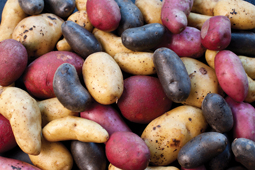“We’re not going to make anymore land, so the farmers who are growing potatoes and other crops are always going to be in demand,” he reasons. “If you look at what you’re paying per pound on a potato, it’s one of the cheapest foods out there for what you get in nutrients.” Demand aside, Rerick anticipates a clear relationship between rapid global population growth and increasing demand for efficient, nutrient-rich crops like potatoes.
Although demand for potatoes has been healthy and is likely to remain so, in Rerick’s view, growers in the valley face increasing transportation problems as they try to get their potatoes to market. The North Dakota oil boom has vastly diminished the supply of trucks and rail car access to potato grower-shippers and other agricultural producers, as well as heightening competition for rail access.
Midwest
One of North Dakota’s longstanding competitors in the potato industry, Wisconsin is the leading potato-growing state east of the Mississippi. Russets, round whites, round reds, yellow flesh potatoes, and purple and blue spuds are grown in the Badger State. Planting begins in late April or early May with harvest between mid-August and October.
Chuck Curl, sales operations manager at RPE, Inc. in Bancroft, WI, recognizes and appreciates the favorable weather the Midwest usually provides during the growing and harvesting season. “One of the best growing years we had was a few years ago,” Curl recollects, “where we had ample sunshine—as a matter of fact, an incredible amount of sunshine—and it never really got much above the upper eighties during the days. In the evenings it would stay relatively mild, in the upper sixties. So with proper water, those are the perfect temperatures for our potatoes.”
Wisconsin potatoes are also relatively free of pests, according to Curl. However, as in other regions, growers must remain vigilant in identifying and combating late blight. Curl also describes several weather-related defects that threaten Midwestern potatoes, such as pressure cracks caused by excessive heat, and ‘hollow heart,’ which results from too-rapid growth.
A major challenge in the past year or so, however, has been transportation. “We’re seeing at peak times during the year an inadequate capacity supply in transportation,” Curl explains, “meaning we don’t have enough trucks to haul the product to the marketplace. We’re trying to utilize more rail, but there’s still a tremendous demand for truck transportation to make sure we can get the spuds to the marketplace.” Curl adds that equipment shortages have led to freight rate increases, and the higher cost of transportation has meant higher costs for consumers.
Curl’s outlook for the potato industry is bright, especially with strong consumer demand for organic potatoes and the specialty varieties that RPE has been working hard to develop—for instance, Ruby Sensations, Honey Golds, and a medley pack of smaller potatoes sold under RPE’s “Tasteful Selections” line.



